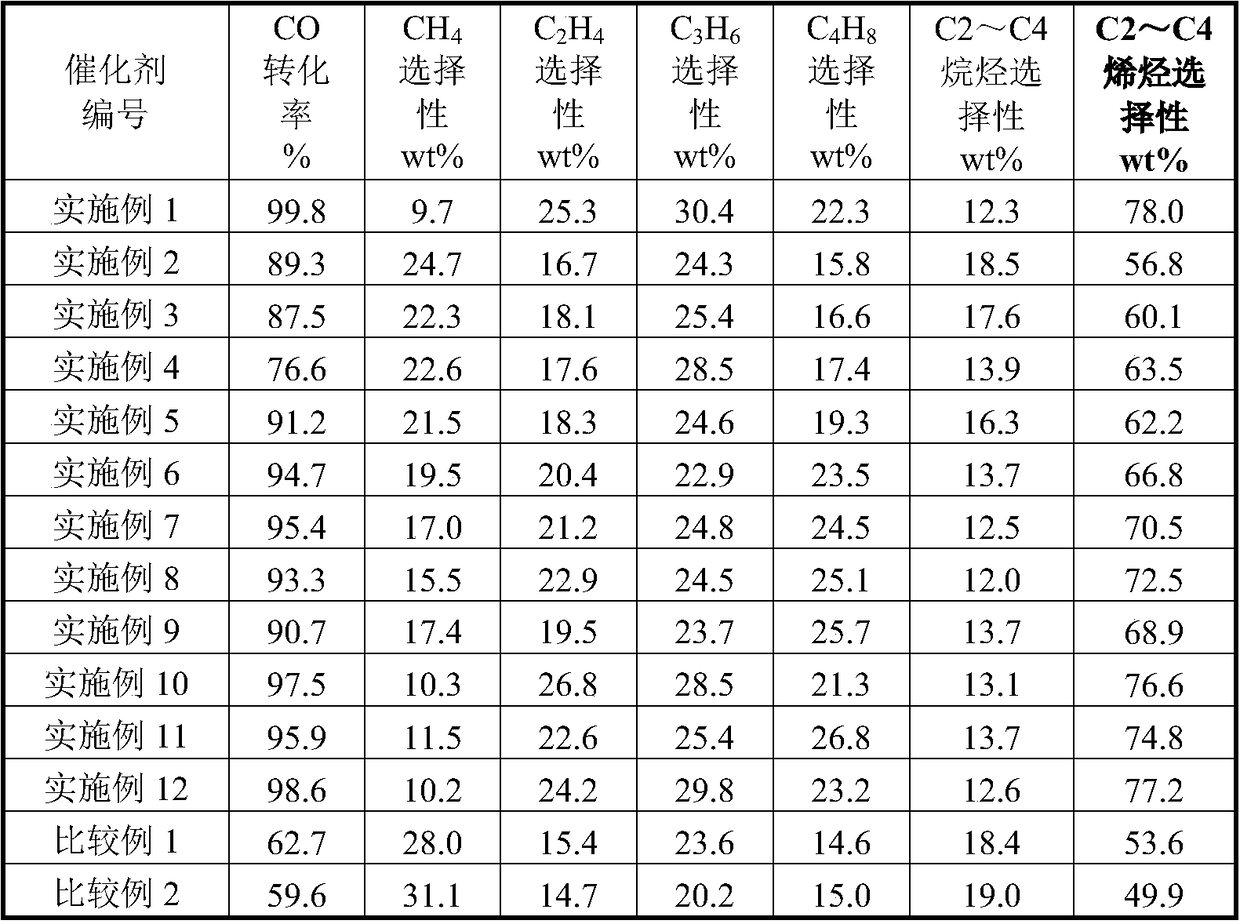Sintered catalyst for producing low-carbon olefins from syngas and preparation method thereof
A technology of low-carbon olefins and catalysts, which is applied in the field of sintered synthesis gas-based low-carbon olefin catalysts and its preparation, which can solve the problems of low selectivity of low-carbon olefins, low CO conversion rate, poor thermal stability, etc., and achieve improved selectivity , reduced internal diffusion resistance, good thermal stability
- Summary
- Abstract
- Description
- Claims
- Application Information
AI Technical Summary
Problems solved by technology
Method used
Image
Examples
Embodiment 1
[0027] Take by weighing 40.0 grams of ferric oxide (Fe 3 o 4 ), 4.0 grams of cobalt oxide (CoO), 10.0 grams of calcium oxide (CaO), 10.0 grams of silicon dioxide (SiO 2 ), 32.0 grams of titanium oxide (TiO 2 ) and 4.0 grams of indium oxide (In 2 o 3 ) six kinds of raw materials and 5 grams of hydroxyethyl cellulose of 5% by weight in the total amount of raw materials, milled and mixed for 4 hours in a ball mill; The kneaded material is kneaded until soft; the kneaded material is sent into the extruder, made into a strip with a diameter of 5mm, and cut into a column with a length of 20mm. After natural drying, it is sent to the drying machine. In the equipment, dry at 120°C for 8 hours for later use; send the dried precursor into a high-temperature furnace, calcinate at 1600°C for 4.0 hours, and after cooling, crush and sieve into 60-80 meshes to obtain the required sintered synthesis gas Preparation of low carbon olefin catalysts. The prepared catalyst comprises the foll...
Embodiment 2
[0029] Weigh 67.5 grams of ferric oxide (Fe 3 o 4 ), 0.5 grams of cobalt oxide (CoO), 3.0 grams of calcium oxide (CaO), 3.0 grams of silicon dioxide (SiO 2 ), 13.0 grams of titanium oxide (TiO 2 ) and 13.0 grams of indium oxide (In 2 o 3 ) six kinds of raw materials and 5 grams of hydroxyethyl cellulose of 5% by weight according to the total amount of raw materials, milled and mixed for 2 hours in a ball mill; The kneaded material is kneaded until soft; the kneaded material is sent into the extruder, made into a strip with a diameter of 5mm, and cut into a column with a length of 20mm. After natural drying, it is sent to the drying machine. In the equipment, dry at 120°C for 8 hours for later use; send the dried precursor into a high-temperature furnace, calcinate at 1600°C for 4.0 hours, and after cooling, crush and sieve into 60-80 meshes to obtain the required sintered synthesis gas Preparation of low carbon olefin catalysts. The prepared catalyst comprises the follow...
Embodiment 3
[0031] Weigh 30.0 grams of ferric oxide (Fe 3 o 4 ), 5.5 grams of cobalt oxide (CoO), 22.0 grams of calcium oxide (CaO), 22.0 grams of silicon dioxide (SiO 2 ), 20.0 grams of titanium oxide (TiO 2 ) and 0.5 g of indium oxide (In 2 o 3 ) six kinds of raw materials and 5 grams of hydroxyethyl cellulose that are 5% by weight in terms of the total amount of raw materials were ground and mixed for 5 hours in a ball mill; The kneaded material is kneaded until soft; the kneaded material is sent into the extruder, made into a strip with a diameter of 5mm, and cut into a column with a length of 20mm. After natural drying, it is sent to the drying machine. In the equipment, dry at 120°C for 8 hours for later use; send the dried precursor into a high-temperature furnace, calcinate at 1600°C for 4.0 hours, and after cooling, crush and sieve into 60-80 meshes to obtain the required sintered synthesis gas Preparation of low carbon olefin catalysts. The prepared catalyst comprises the ...
PUM
 Login to View More
Login to View More Abstract
Description
Claims
Application Information
 Login to View More
Login to View More - R&D
- Intellectual Property
- Life Sciences
- Materials
- Tech Scout
- Unparalleled Data Quality
- Higher Quality Content
- 60% Fewer Hallucinations
Browse by: Latest US Patents, China's latest patents, Technical Efficacy Thesaurus, Application Domain, Technology Topic, Popular Technical Reports.
© 2025 PatSnap. All rights reserved.Legal|Privacy policy|Modern Slavery Act Transparency Statement|Sitemap|About US| Contact US: help@patsnap.com



